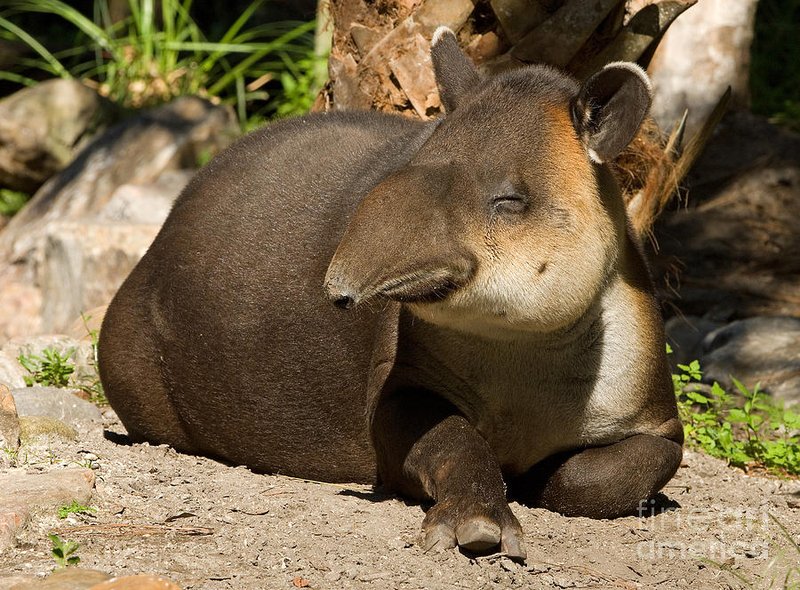
Baird’s tapirs, found in Central America, rely on their physical adaptations and behaviors to thrive. They may look a bit like oversized, stocky pigs with long snouts, but there’s so much more to them than meets the eye. Today, we’ll explore how these incredible creatures face harsh environments, tackle food scarcity, and handle the ongoing threats posed by their habitats. So grab your favorite drink, and let’s get into the world of Baird’s tapirs!
Habitat and Range of Baird’s Tapirs
Baird’s tapirs are predominantly found in Central America, ranging from southern Mexico down to western Ecuador. They thrive in a variety of habitats, including tropical rainforests, riversides, and wetlands. These environments are rich in biodiversity, providing tapirs with their daily needs—a mix of privacy, food, and water.
Their choice of habitat is crucial for survival. The dense foliage of forests offers them cover from predators, such as jaguars and humans. You might be wondering why they prefer such specific areas. Well, it’s simple: these habitats are filled with fruits, leaves, and aquatic plants that are essential for their diet.
Moreover, tapirs are excellent swimmers, often using water bodies to escape threats. When they feel danger nearby, they can swiftly dive into the water. Think of them as nature’s stealthy ninjas, slipping away quietly while others draw attention to themselves. This adaptability to both land and water environments is key to their resilience.
Physical Adaptations for Survival
Baird’s tapirs have some fascinating physical traits that help them navigate their tough environments. Their large size—weighing anywhere from 500 to 800 pounds—serves as a deterrent against many predators. But it’s not just their weight that keeps them safe. Their stout bodies and short legs allow them to move effortlessly through thick underbrush, while their long, flexible snouts help them reach for leaves or fruits high in trees.
With that long snout, Baird’s tapirs can also pick their food with precision. It’s almost like having a built-in grabber tool, allowing them to forage efficiently. Instead of struggling to bend down or leap up, they simply extend their snouts to capture whatever looks tasty. Honestly, it’s a pretty clever solution to the challenges of finding food in their dense habitats.
Another interesting feature is their skin. Baird’s tapirs have tough skin that helps protect them against thorns and sharp plants in their environments. This means they can roam freely without worrying too much about getting hurt. It’s a bit like wearing a natural suit of armor!
Diet and Foraging Techniques
The diet of a Baird’s tapir mainly consists of fruits, leaves, and aquatic plants. They are herbivores, so they spend a good chunk of their day foraging for food. You might picture them munching on tasty fruits or snacking on some fresh leaves, right? But it’s not always so straightforward.
To find food, tapirs have adapted their habits to suit their environments. During the day, they often stay hidden in the dense underbrush, venturing out mostly at night when it’s cooler and quieter. This behavior helps them avoid predators and human disturbances. Think of it as their way of keeping a low profile.
Additionally, Baird’s tapirs have developed a unique method for foraging. They utilize their sense of smell to detect ripe fruits or tender leaves from a distance. Once they find a good spot, they’ll use their snouts to dig around or uproot plants. This way, they ensure they’re getting the nutrients they need, even when food might be harder to come by.
Water Sources and Their Importance
Water is crucial for all living beings, and Baird’s tapirs are no exception. They need water for drinking, but it’s also vital for their daily activities. These tapirs are known to spend a lot of time in water bodies, using them for cooling off and escaping from potential dangers. Imagine how refreshing a dip would be on a hot day!
During the dry season, finding water can become a real challenge. Tapirs often have to travel further to locate reliable sources. This is where their adaptability shines. They can remember previous watering holes and navigate through complex terrains to get there. Their ability to journey across diverse landscapes highlights their survival skills.
Moreover, the aquatic plants in these water sources also serve as a food resource. They can munch on water lilies and other submerged vegetation, making their time in the water even more worthwhile. Here’s the thing: Baird’s tapirs are not just water lovers; they are strategic when it comes to how they use these resources.
Conservation Challenges and Efforts
While Baird’s tapirs have their survival strategies, they are not invincible. Their populations are threatened due to habitat destruction and hunting. As humans continue to encroach on their environments, tapirs find themselves in increasingly precarious situations. Deforestation, driven by agriculture and urbanization, reduces their natural habitats, leaving them vulnerable.
Conservation efforts are underway, with various organizations working to protect their habitats and educate local communities about the importance of preserving these gentle giants. Creating wildlife reserves and enforcing protective laws can help ensure Baird’s tapirs have safe spaces to thrive.
It’s essential to understand that every species plays a role in its ecosystem. By saving tapirs, we’re also preserving the rich biodiversity of their habitats. This means more than just saving an animal; it’s about maintaining the balance of nature itself.
Baird’s tapirs are a stunning example of nature’s adaptability and resilience. They navigate harsh environments with grace, using their unique features to survive and even thrive. From their formidable size and stealthy foraging techniques to their love for water, these creatures have developed remarkable strategies that allow them to overcome challenges.
As we continue to learn about Baird’s tapirs, it becomes even clearer just how essential they are to the ecosystems they inhabit. By appreciating their struggles and the steps being taken to protect them, we can contribute to a brighter future for these incredible animals. So next time you hear about Baird’s tapirs, remember their story—one of perseverance in the face of adversity, and an enduring spirit that deserves our respect and protection.

